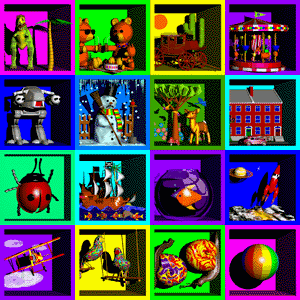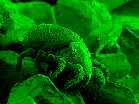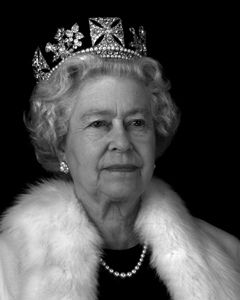Technical milestones
Rob Munday, with his company Spatial Imaging, has developed many new and innovative holographic techniques and technologies over the last four decades. In particular, Rob's innovations in digital holography were instrumental in transforming the hologram mastering process from an extremely labour-intensive and skilled process to a near-automated one, which in turn greatly influenced the growth and success of the holographic industry worldwide during the 1990's and 2000's. Rob's creative and technical contributions to holography and three-dimensional imaging were recognised in 2005 when he was awarded the prestigious Saxby Medal by the Royal Photographic Society of London.
1985 - Rob designed and built a dedicated ruby-pulsed laser holographic portrait studio at the Royal College of Art. At this time it was the only purpose-built holographic portrait studio outside of the USA and one of the first in the world. Using the RCA's pulsed-laser studio, Rob created some of the first holograms of living animals, and was described by one magazine as the world's first 'wildlife holographer'.





See: Practical Holography First Edition by Graham Saxby - 1988 - Plate 20
See: Ultra Realistic Imaging by Hans Bjelkhagen and David Brotherton-Ratcliffe, 2013 - Page 16 - Holographic Portraits
1985 - Rob inadvertently discovered a new formula for pulsed laser transmission hologram developer. The formula, first given to him by Prof. Nick Phillips, called for 0.2g of Phenidone, however, Rob inadvertently put 2g of Phenidone in the developer. This increase in Phenidone gave much brighter H1 master holograms with less noise. Rob's new recipe, all be it later modified again to use 1g of Phenidone, was used for all transmission holograms at the RCA, by himself, and by many holographers worldwide from that point onwards, including Fred Unterseher for his holographic portraits.
1986 - Not strictly speaking a milestone, but an unforgettable experience. In 1987 Prof. Nick Phillips invited Rob Munday to assist him with a lecture on holography at the hallowed Royal Institution, London, founded in 1799. Rob held holograms aloft above the famous desk used by the likes of Muybridge to demonstrate the first moving images, Maxwell to demonstrate colour photography, Thompson to announce the discovery of electrons, and Michael Farraday to demonstrate electromagnetism.
1988 - Rob created the world’s first home micro-computer-generated holographic stereogram using a Commodore Amiga computer and Sculpt 3D software. The images were output to film and the hologram was recorded using an early holographic stereogram recording system designed and built by Prof. Nick Phillips at Loughborough University.
See: Holographics International Magazine, Summer 1989 - Page 8 - Munday Makes It With an Amiga

1989-1991 - Rob designed and built the world’s first computer-automated 3D digital holographic stereogram recording system, a digital hologram printer known as the DI-HO system (Digital Input - Hologram Output).
See: Ultra Realistic Imaging by Hans Bjelkhagen and David Brotherton-Ratcliff, 2013 - Pages 34-37 - Holographic Stereograms
See: Practical Holography Fourth Edition by Graham Saxby, 2017 - Chapter 21 - Digital Stereograms



1992 - Early in 1992, using the DI-HO, Rob created the world's first digital 3D reflection and embossed holographic stereograms.
See: Holography News 1992
See: Practical Holography Third Edition by Graham Saxby, 1992 - Plate 14
See: Practical Holography Fourth Edition by Graham Saxby, 2017 - Chapter 21 - Digital Stereograms


The world's first 3D digital embossed hologram Z and the world's first 3D digital reflection hologram Triceratops


1992/3 - Rob also created the world's first full colour animated digital holograms made from flat sequences of video images, which Munday named Moviegrams. Moviegrams were made for music CD covers, including for the band Queen - The Ultimate Collection, Boyzone, Wet Wet Wet and Mike Oldfield, book covers, toys, greetings cards and many other commercial products.
1993 - Rob made the world's largest single hologram for Royal College of Art graduate and artist Caius Hawkins. This laser transmission hologram artwork was created using a single piece of holographic film and with a single exposure and was approx 1 x 2.5 metres in size. It was displayed at the London Science Museum, illuminated with an argon laser. It is thought to remain the world's largest non-tiled hologram.
1996 - Rob invented a new optical technique and system to produce the world’s highest resolution, directly written digital ‘dot matrix’ holograms. Originally known as the Lightgate 1270, and later the Lightgate B, it was also the fastest dot-matrix hologram recording system of its time. The Lightgate system was the world's first dot-matrix system that was capable of making sophisticated security holograms and wide-angle 3D stereograms with parallax. Between 1996 and 2006, over 40 Lightgate B systems were sold worldwide, into what was then a relatively small holography industry. At this time, only a handful of companies had cornered the security hologram market however Rob's Lightgate B system enabled many smaller companies to enter the market, and thus was instrumental in the growth of the security hologram industry in the 00's into a billion-dollar industry.
See: Practical Holography Fourth Edition by Graham Saxby, 2017 - Chapter 21 - Dot Matrix

1998 - Rob developed and wrote the software to create the world’s first wide-angle, full-colour 3D digital 'dot matrix' holographic stereograms with parallax. Called 3Digital, Rob was awarded an IHMA Award of Excellence for the category New Holographic Technique in the year 2000. See: Practical Holography Fourth Edition by Graham Saxby, 2017 - Chapter 21 - Dot Matrix


1998 - Rob developed and wrote the software to create a new optical security feature, a new kind of a 'laser projected hidden image'. This feature was the first of its kind to be made using a digital ‘dot matrix mastering system, and created by forming an array of diffractive pixels, whereby each pixel directs light to a single point in 3D space some distance from the hologram. When the entire pixel array is illuminated with a laser a complete image or word is formed in space and can be projected onto a viewing screen. A further variation involved randomizing the position of each pixel in the array. Since 1998, laser-projected hidden images of this kind have been used and can be found on almost every one of the billions of document security and brand authentication holograms that have been mastered with a digital dot-matrix mastering system.

1998 - Working with Mike C Hutley, a physicist best known for his seminal 1982 book ‘Diffraction Gratings’. Rob created a micro-lens array security feature whereby the micro-print on the back of the lens array was provided by a dot-matrix hologram containing micro-text and micro-symbols. It was thought to be the first time that a micro-lens array and a hologram had been combined to create a new optical security device.
2000 - At 2000 dpi, Rob and his employee, Jeffrey Robb created the world's highest-resolution dot matrix brand authentication hologram, and also a DI-HO digital stereogram, for London's Millennium Dome merchandise to celebrate the year 2000.
2002 - Rob built a multi-video camera system to record live 3D video with parallax. The resultant footage was designed to be shown on one of the world's first auto-stereoscopic glasses-free 3D TV's, the SynthaGram from StereoGraphics Corporation, USA. Munday was later told by StereoGraphics Corporation that this may well have been the world's first multi-camera parallax video recording system and subsequently the world's first live parallax video recording. Munday commented that the resulting 3D video, a short clip of a theatre play showing a female actress centre stage, was as near to emulating the famous Star War's Princess Leah 'hologram' as had been achieved to that point.

2003 - Rob was commissioned to create the first-ever officially commissioned 3D portrait of Her Majesty the Queen and he chose to create a holographic stereogram. In order to create the best possible portrait, from both an artistic and technical point of view, Rob designed and built the VIP (Video Images with Parallax) camera system. The VIP utilised the world’s highest resolution and fastest digital camera available at the time to create 38 parallax image sequences, each comprising of 208 frames, of Her Majesty the Queen. The VIP system remains one of the most sophisticated parallax image capture systems of its kind.



2004 - In order to create the best possible holographic and lenticular stereographic portraits of Her Majesty the Queen, using the image sequences he captured in 2003/2004, Rob developed a process for digitally reversing the various distortions inherent in such image sequences after they had been shot, including keystone distortion. David Burder FRPS, a world-renowned 3D photographer and lenticular image maker, thought this to be the first time that such a process had been employed for stereographic image making. This led to an even more realistic and technically proficient 3D portrait.
2004 - Having had the idea several years before, Rob applied for a patent on a method of producing holograms using conventional ink. The technique involved modulating the pixels of a digital dot matrix holographic optical element array using conventional ink so as to produce a tonal 3D holographic stereogram. See patent application US20090040578A1
2004 - Rob invented several new optical techniques and direct-write digital dot-matrix hologram recording systems, this time to create the world’s largest digital holograms and the world’s fastest systems. Known as the Lightgate S and Lightgate P systems they were capable of making holograms and diffractive patterns in excess of 1 * 1.5 meters in size and at extremely high speed. The systems won an IHMA Award of Excellence for both the New Holographic Technique and the BEST OF THE YEAR categories in 2005 and they remain the fastest digital hologram printers. See patent application US20070258119A1


2007/2008 - Rob created some of the first directly written, one-step, dot-matrix, 3D digital reflection holographic stereograms using Bayer photopolymer material. To do so he exposed a mirror-backed photopolymer film with a single angular and intensity-modulating beam of light, Lippmann style, to create pixellated dot-matrix reflection holograms.
Rob also developed a process for mass-reproducing photopolymer reflection hologram copies by contact copying directly from a metalized reflective surface-relief master hologram. These photopolymer reflection holograms were shown at the 2008 HoloPack HoloPrint conference in Toronto.
2012 - Rob developed the Lightgate X system, a high security, super high resolution, and fast digital hologram and mastering system that utilised the techniques of interference lithography and photo-microlithography.
2013-2016 - Rob focussed on lenticular imaging and his artworks. During this time he worked with lenticular printer Jake Purchase to increase the quality of deep 3D lenticular images and was the first artist in the world to utilise high-quality UV resin cast lenticular lens films laminated to glass to make large format deep 3D lenticular artworks. See www.rob-munday.com for Rob's artistic accomplishments.
2017- Present - Rob is currently focused on the development of new and high-quality lenticular lenses for the lenticular imaging, display, and fine art industries and for his use as an artist.
Rob is also working as a consultant with Raith Laser Systems B.V. (formerly 4Pioc B.V.) to enhance their world-leading DWL hologram mastering systems technology and software, and also continuing to develop his software to assist all aspects of the holographic and lenticular 3D image-making process.
Over the last 35 years, Rob has designed and written many innovative computer programs and computer algorithms to control all aspects of the digital holographic imaging and mastering process.
Books that describe Rob's technical accomplishments include:
Practical Holography - All editions, including Fourth Edition by Graham Saxby and Stanislovas Zacharovas, 2017 - CPR Press
See: Practical Holography - First Edition by Graham Saxby, 1988 - Plate 20
See: Practical Holography - Third Edition by Graham Saxby, 1992 - Plate 14
See: Practical Holography Fourth Edition by Graham Saxby, 2017 - Chapter 21 - Digital Stereograms
See: Practical Holography Fourth Edition by Graham Saxby, 2017 - Chapter 21 - Dot Matrix
Ultra-Realistic Imaging: Advanced Techniques in Analogue and Digital Colour Holography by Hans Bjelkhagen, David Brotherton-Ratcliffe - 2013 - CPR Press
See: Ultra Realistic Imaging by Hans Bjelkhagen and David Brotherton-Ratcliffe - 2013 - Pages 34-37 - Holographic Stereograms
Holographic Visions, A History of New Science by Sean F. Johnston, 2006 - Oxford University Press
Also, see www.rob-munday.com for Rob Munday's artistic accomplishments.